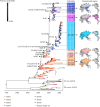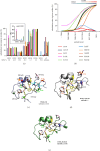Phylodynamics and Molecular Mutations of the Hemagglutinin Affecting Global Transmission and Host Adaptation of H5Nx Viruses
- PMID: 40303705
- PMCID: PMC12017097
- DOI: 10.1155/2023/8855164
Phylodynamics and Molecular Mutations of the Hemagglutinin Affecting Global Transmission and Host Adaptation of H5Nx Viruses
Abstract
Highly pathogenic avian influenza (HPAI) H5 viruses have circulated globally causing incidental human infection with a substantial pandemic threat. The present study investigated the molecular evolution and phylodynamics of hemagglutinin (HA) in avian and human-isolated H5Nx viruses globally circulating since 2000. We investigated the dynamics of amino acid substitution in the HA sequences of avian and human H5Nx viruses and performed a phylogenetic analysis. Our study found that the H5Nx lineages dominantly expanded since 2000 and diverged into multiple sublineages with unique genetic mutations. P185S mutation in HA became a molecular characteristic of dominant H5Nx viruses throughout clades 2.3.4.1 to 2.3.4.4 (2.3.4.1-4). The key mutations, ΔE130 and I155T, and potential N-linked glycosylation at residues 128, 144, and 159 in the HA gene of human-isolated viruses possibly contributed to both the individual and population levels of the H5 evolution and the host adaptation. Our analysis detected heterogeneity in amino acid sites under positive selection in the HA gene of clades 2.3.4.1-4. Accumulated mutations in the HA protein may potentially affect not only the genetic and antigenic diversity of HPAI H5Nx viruses but also increase the functional compatibility with NA subtypes. Given the global spread and incessantly occurring HA mutations of H5Nx viruses, our results emphasize the importance of early identification of HA mutations as well as the need for a comprehensive assessment of H5Nx variants in terms of pandemic preparedness.
Copyright © 2023 Atanas V. Demirev et al.
Conflict of interest statement
The authors declare that they have no conflicts of interest.
Figures



Similar articles
-
Genetic evolution of hemagglutinin and neuraminidase genes of H5N1 highly pathogenic avian influenza viruses in Thailand.PeerJ. 2022 Nov 30;10:e14419. doi: 10.7717/peerj.14419. eCollection 2022. PeerJ. 2022. PMID: 36518286 Free PMC article.
-
T160A mutation-induced deglycosylation at site 158 in hemagglutinin is a critical determinant of the dual receptor binding properties of clade 2.3.4.4 H5NX subtype avian influenza viruses.Vet Microbiol. 2018 Apr;217:158-166. doi: 10.1016/j.vetmic.2018.03.018. Epub 2018 Mar 17. Vet Microbiol. 2018. PMID: 29615249
-
Multiple HA substitutions in highly pathogenic avian influenza H5Nx viruses contributed to the change in the NA subtype preference.Virulence. 2022 Dec;13(1):990-1004. doi: 10.1080/21505594.2022.2082672. Virulence. 2022. PMID: 36560870 Free PMC article.
-
Emergence and dissemination of clade 2.3.4.4 H5Nx influenza viruses-how is the Asian HPAI H5 lineage maintained.Curr Opin Virol. 2016 Feb;16:158-163. doi: 10.1016/j.coviro.2016.02.005. Epub 2016 Mar 15. Curr Opin Virol. 2016. PMID: 26991931 Review.
-
The genetics of highly pathogenic avian influenza viruses of subtype H5 in Germany, 2006-2020.Transbound Emerg Dis. 2021 May;68(3):1136-1150. doi: 10.1111/tbed.13843. Epub 2020 Sep 29. Transbound Emerg Dis. 2021. PMID: 32964686 Review.
References
-
- Boltz D. A., Seiler P., Govorkova E. A., et al. Mondry R. Emergence of H5N1 avian influenza viruses with reduced sensitivity to neuraminidase inhibitors and novel reassortants in Lao People’s Democratic Republic. Journal of General Virology . 2010;91(4):949–959. doi: 10.1099/vir.0.017459-0. - DOI - PMC - PubMed
MeSH terms
Substances
LinkOut - more resources
Full Text Sources
Medical

